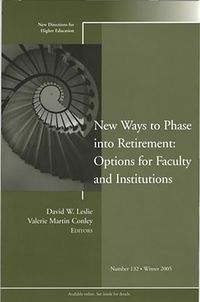
New Ways to Phase into Retirement: Options for Faculty and Institutions: Ne Upplaga 1
This volume explores all aspects of phased retirement, an option that provides flexibility for faculty who intend to retire but may have good reason to do so gradually instead of all at once. It is well known now that colleges and universities can no longer tell faculty when they must retire. Instead, faculty can now tell their institutions when they will stop working. For years prior to 1994, the impending federal abolition of mandatory retirement caused colleges and universities to worry that faculty might choose never to retire. The specter of an infinitely aging and increasingly costly gerontocracy ruling the classrooms, labs, and committee structures of universities led to varied experiments with incentives and inducements to make retirement attractive to faculty members. This volume looks at how one of these newer options, phased retirement, works. "New Ways to Phase Into Retirement" is the 132nd issue of the quarterly higher education report "New Directions for Higher Education, " published by Jossey-Bass.
Upplaga: 1a upplagan
Utgiven: 2006
ISBN: 9780787985691
Förlag: John Wiley & Sons
Format: Häftad
Språk: Engelska
Sidor: 96 st
This volume explores all aspects of phased retirement, an option that provides flexibility for faculty who intend to retire but may have good reason to do so gradually instead of all at once. It is well known now that colleges and universities can no longer tell faculty when they must retire. Instead, faculty can now tell their institutions when they will stop working. For years prior to 1994, the impending federal abolition of mandatory retirement caused colleges and universities to worry that faculty might choose never to retire. The specter of an infinitely aging and increasingly costly gerontocracy ruling the classrooms, labs, and committee structures of universities led to varied experiments with incentives and inducements to make retirement attractive to faculty members. This volume looks at how one of these newer options, phased retirement, works. "New Ways to Phase Into Retirement" is the 132nd issue of the quarterly higher education report "New Directions for Higher Education, " published by Jossey-Bass.
Begagnad bok (0 st)
Varje vecka tillkommer tusentals nya säljare. Bevaka boken så får du meddelande när den finns tillgänglig igen.



